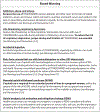Warning Labels as a Public Health Intervention: Effects and Challenges for Tobacco, Cannabis, and Opioid Medications
- PMID: 38166502
- PMCID: PMC12278888
- DOI: 10.1146/annurev-publhealth-060922-042254
Warning Labels as a Public Health Intervention: Effects and Challenges for Tobacco, Cannabis, and Opioid Medications
Abstract
Warning labels help consumers understand product risks, enabling informed decisions. Since the 1966 introduction of cigarette warning labels in the United States, research has determined the most effective message content (health effects information) and format (brand-free packaging with pictures). However, new challenges have emerged. This article reviews the current state of tobacco warning labels in the United States, where legal battles have stalled pictorial cigarette warnings and new products such as electronic cigarettes and synthetic nicotine products pose unknown health risks. This article describes the emerging research on cannabis warnings; as more places legalize recreational cannabis, they are adopting lessons from tobacco warnings. However, its uncertain legal status and widespread underestimation of harms impede strict warning standards. The article also reviews opioid medication warning labels, suggesting that lessons from tobacco could help in the development of effective and culturally appropriate FDA-compliant opioid warning labels that promote safe medication use and increased co-dispensing of naloxone.
Keywords: cannabis; opioid medications; tobacco; warning labels.
Conflict of interest statement
DISCLOSURE STATEMENT
The authors are not aware of any affiliations, memberships, funding, or financial holdings that might be perceived as affecting the objectivity of this review.
Figures



Similar articles
-
Effects of E-Cigarette Warning Labels About Mental Health Consequences of Nicotine Addiction Among Young Adults in the USA: Results From a Randomized Controlled Experiment.Nicotine Tob Res. 2025 May 22;27(6):1006-1015. doi: 10.1093/ntr/ntae298. Nicotine Tob Res. 2025. PMID: 39657115 Clinical Trial.
-
Perceptions of cannabis warnings and recommendations for improvement: a qualitative study with people who use cannabis from the United States.BMC Public Health. 2025 Jul 3;25(1):2363. doi: 10.1186/s12889-025-23518-1. BMC Public Health. 2025. PMID: 40611026 Free PMC article.
-
Relative Efficacy of Cigarillo Warning Statements in Text and Pictorial Formats: An Experimental Study Among a Sample of US Young Adults.Nicotine Tob Res. 2025 Feb 24;27(3):525-533. doi: 10.1093/ntr/ntae228. Nicotine Tob Res. 2025. PMID: 39320986 Clinical Trial.
-
Tobacco packaging design for reducing tobacco use.Cochrane Database Syst Rev. 2017 Apr 27;4(4):CD011244. doi: 10.1002/14651858.CD011244.pub2. Cochrane Database Syst Rev. 2017. PMID: 28447363 Free PMC article.
-
Interventions to reduce harm from continued tobacco use.Cochrane Database Syst Rev. 2016 Oct 13;10(10):CD005231. doi: 10.1002/14651858.CD005231.pub3. Cochrane Database Syst Rev. 2016. PMID: 27734465 Free PMC article.
Cited by
-
Redesigning Pharmacy to Improve Public Health Outcomes: Expanding Retail Spaces for Digital Therapeutics to Replace Consumer Products That Increase Mortality and Morbidity Risks.Pharmacy (Basel). 2024 Jul 12;12(4):107. doi: 10.3390/pharmacy12040107. Pharmacy (Basel). 2024. PMID: 39051391 Free PMC article.
-
Developing and testing health warnings about alcohol and risk for breast cancer: Results from a national experiment with young adult women in the United States.Alcohol Clin Exp Res (Hoboken). 2025 Mar;49(3):665-677. doi: 10.1111/acer.70003. Epub 2025 Feb 22. Alcohol Clin Exp Res (Hoboken). 2025. PMID: 39985486 Clinical Trial.
-
Exploring the effects of cannabis health warnings on protective health intentions among US adults in legal recreational states.Int J Drug Policy. 2024 Jun;128:104450. doi: 10.1016/j.drugpo.2024.104450. Epub 2024 May 15. Int J Drug Policy. 2024. PMID: 38749214 Free PMC article. Clinical Trial.
References
-
- Al-Hamdani M, Joyce KM, Park T, Cowie ME, Stewart SH. 2021. Cannabis packaging: an opportunity for facilitating informed decisions. J. Consumer Aff. 55:1150–68
-
- Allard NC, Kruger JS, Kruger DJ. 2023. Cannabis advertising policies in the United States: state-level variation and comparison with Canada. Cannabis Cannabinoid Res. 8:505–9 - PubMed
-
- Bailey SC, Shrank WH, Parker RM, Davis TC, Wolf MS. 2009. Medication label improvement: an issue at the intersection of health literacy and patient safety. J. Commun. Healthc. 2:294–307
-
- Barry RA, Glantz SA. 2017. Lessons from tobacco for developing marijuana legalization policy. Rep., Cent. Tob. Control Res. Educ., Univ. Calif., San Francisco. http://www.escholarship.org/uc/item/87j477b7
Publication types
MeSH terms
Substances
Grants and funding
LinkOut - more resources
Full Text Sources

